Roast Duck with Maple Glaze has crispy skin and juicy meat. The sweet flavors from maple syrup and fruit juice complement the taste of rich duck meat. A whole roast duck is an easy yet impressive main dish for your next special occasion or holiday dinner.
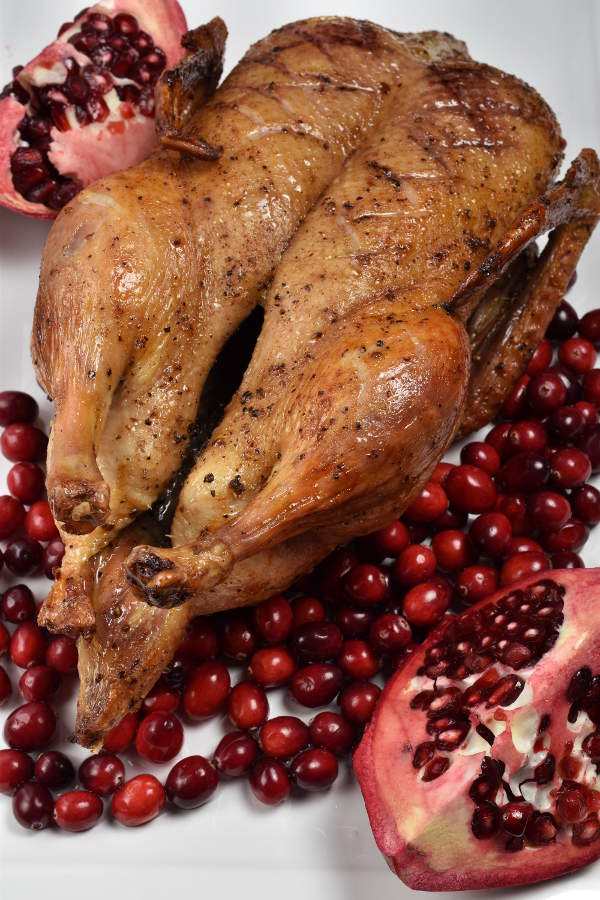
Duck is not something most people eat every day. (If you do, I want to come to your house for dinner!) But there’s no reason to be intimidated by making duck. Aside from the fact that it’s usually sold frozen and you’ll have to wait for it to defrost, roasting a whole duck is no more difficult than roasting a chicken.
Duck meat is fattier than chicken and has a more complex flavor which pairs really well with fruit. That’s why you typically see duck recipes with a variety of fruit sauces. For this recipe, I chose a maple glaze made with maple syrup and a fruit juice blend. I love the touch of sweetness the glaze gives the crispy fatty duck skin. This is such a decadent meal, perfect for the holidays or just dinner next weekend. Pick up a duck next time you’re out shopping and give it a try.
Ingredients for Roast Duck with Maple Glaze
Here are the main ingredients. That’s a five pound white pekin (aka Long Island) duck, paprika, kosher salt, freshly ground black pepper, maple syrup, and a pomegranate-cranberry fruit juice blend. Any type of fruit juice works here.
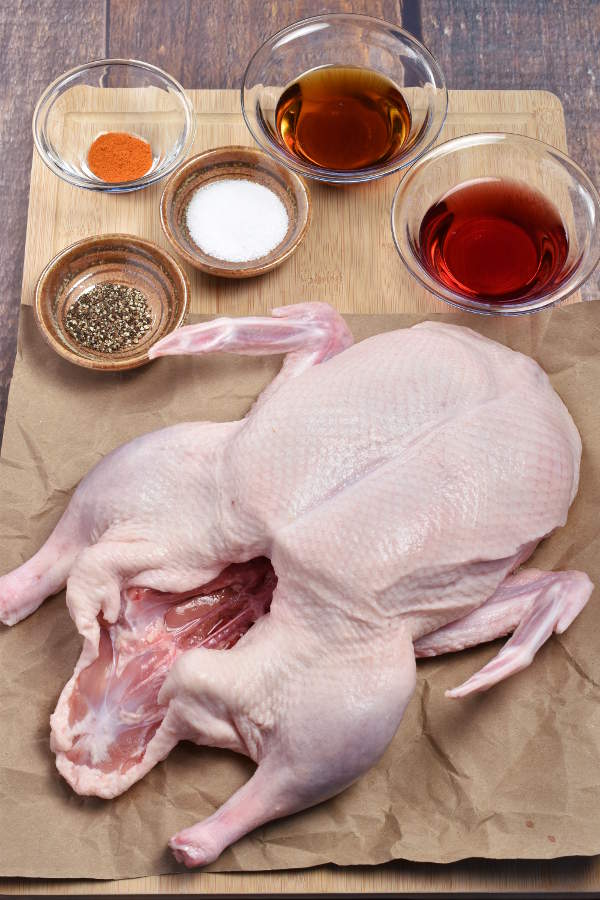
Most grocery stores sell whole duck like this frozen. It takes at least 48 hours to fully defrost a frozen duck in the fridge, but I would leave three days if possible to be on the safe side.
When you defrost the duck, make sure to put it in a plastic bag or bowl or tray or something because I didn’t realize there was a hole in the plastic when mine was frozen, until I picked it up and defrosted duck juice leaked all over the refrigerator. Learn from my mistake!
How to Make Roast Duck with Maple Glaze
First, preheat the oven and prepare your roasting pan with a roasting rack. I don’t have a real roasting rack, but I used the steamer insert from my Instant Pot to keep the duck off the bottom of the roasting pan where the fat drippings collect. Be creative! This worked really well because I could use the handles to lift the duck out of the pan and then pour out the fat.
Next step is to season your duck. Rub paprika, salt, and pepper all over the outside.
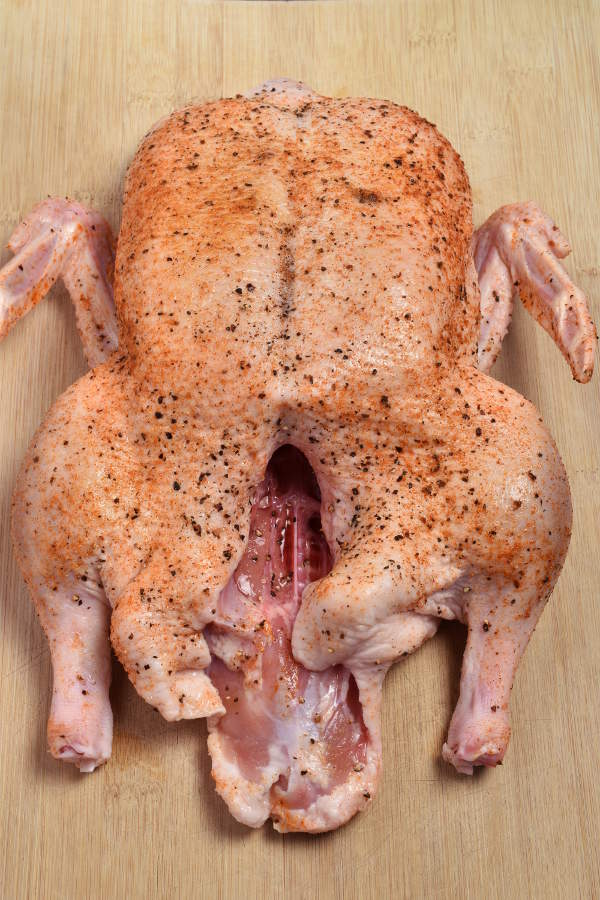
Then use a sharp knife to score the skin over the breasts, thighs, and other thick fatty parts in a crisscross pattern. Try to avoid cutting all the way through the skin. This helps the fat change from solid to liquid form as it cooks.
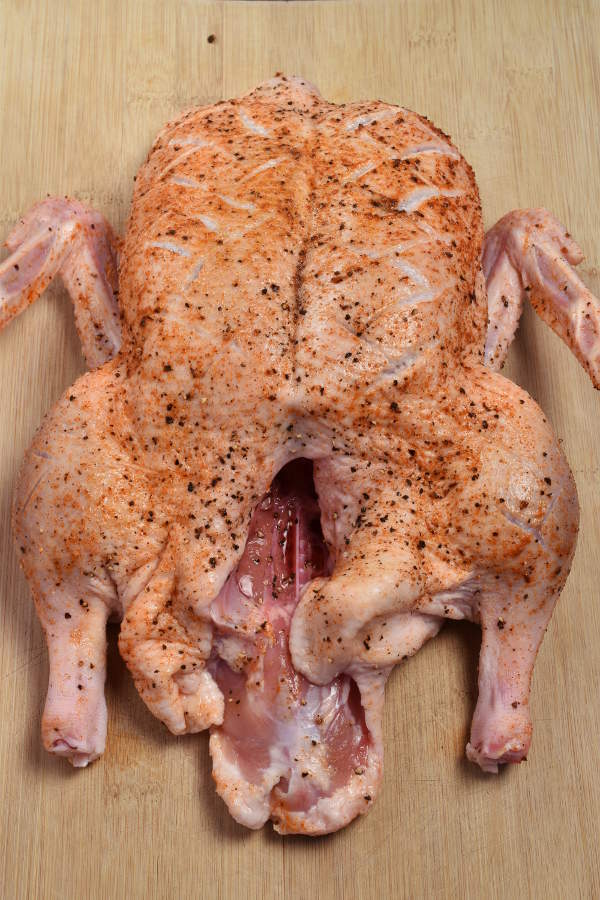
Tie the legs together with cooking twine. Here is my duck, on my improvised roasting rack, ready to go into the oven.
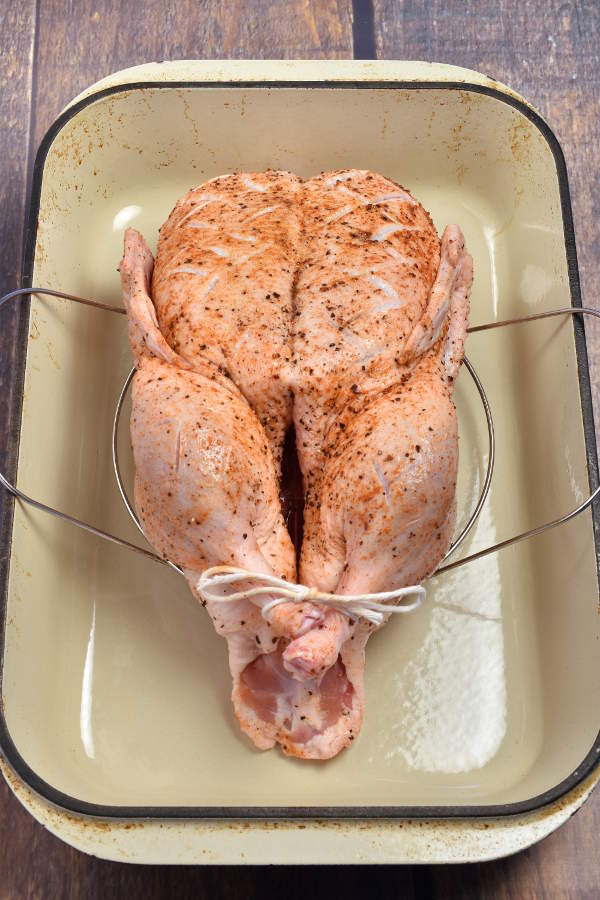
Roast the duck for one hour; then remove from the oven. This is what my duck looked like after one hour.
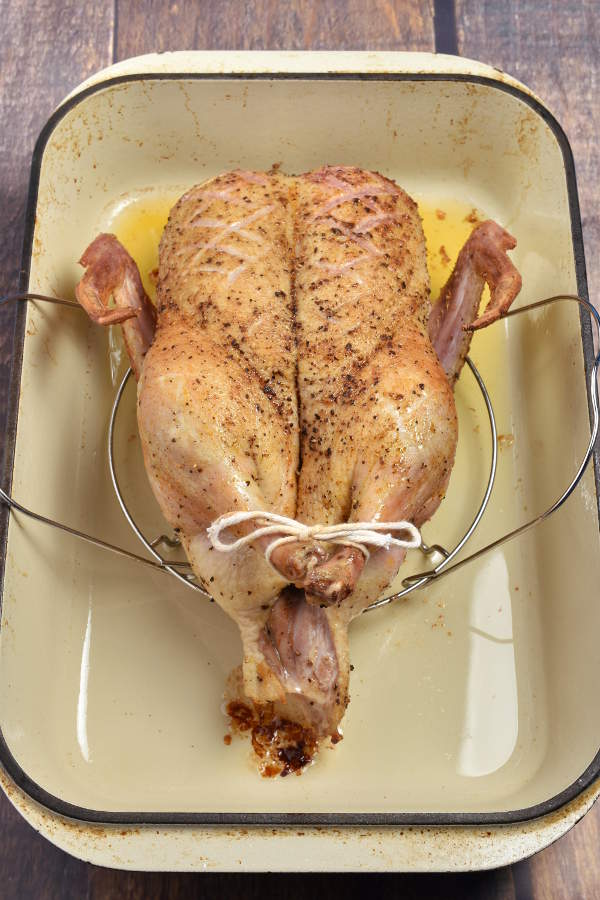
Take the duck out of the pan and remove that melted fat from the bottom of the roasting pan.
Put the duck back in the pan, but this time, flip it over to be breast-side down. It will look like this.
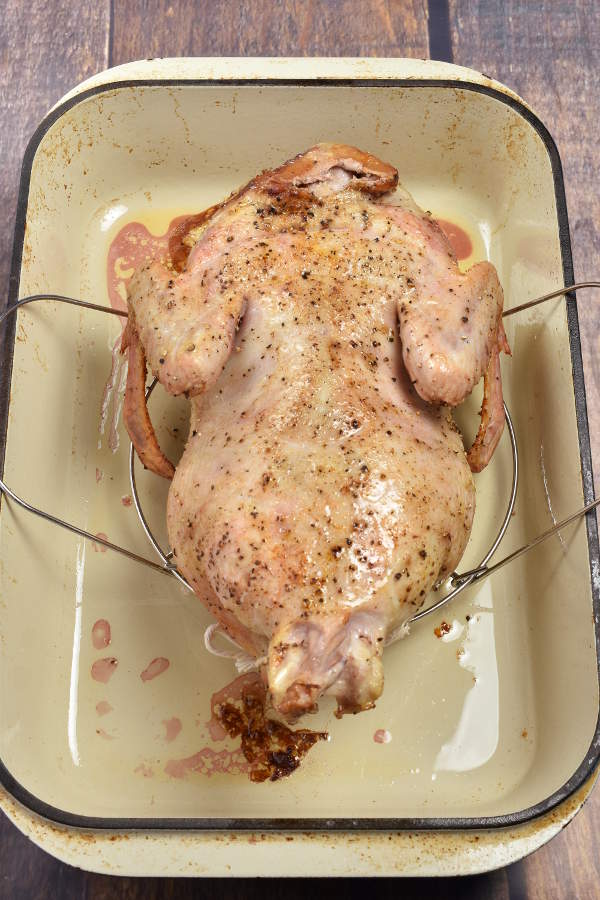
Roast it for another 45 minutes. Here’s what it looks like then.
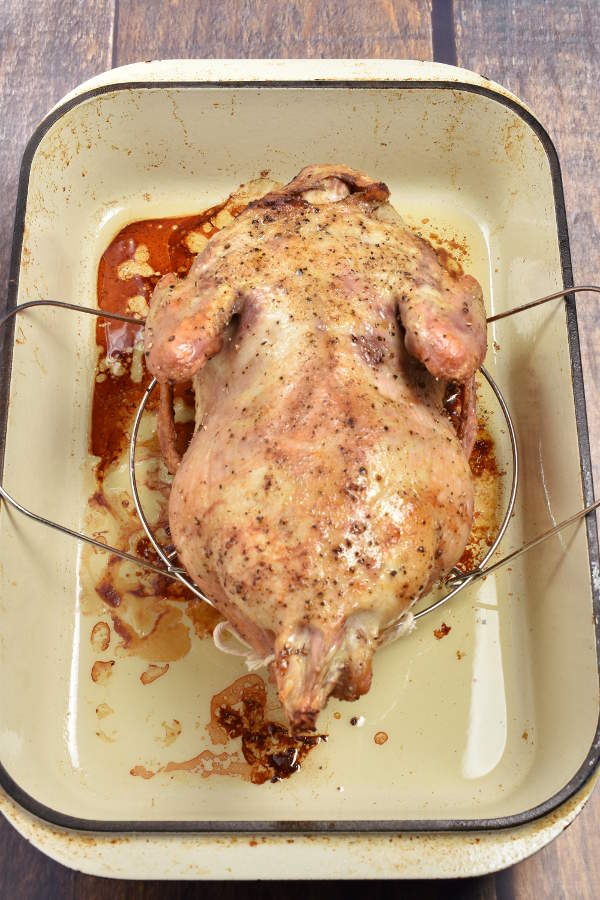
At this point, remove the fat from the roasting pan again. Then flip the duck back over breast side up. Mix the maple syrup and juice together in a small bowl and brush half of it over the duck.
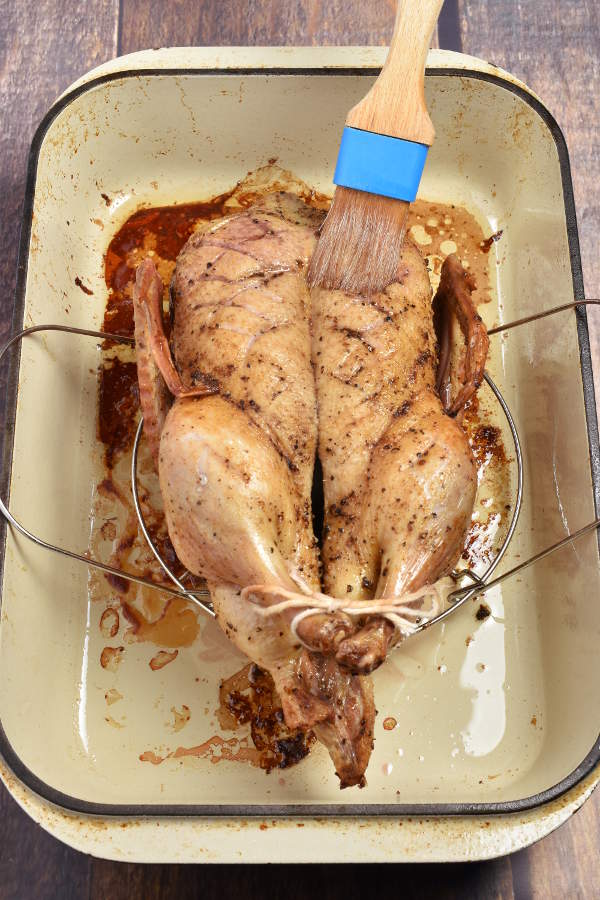
Roast for 15 minutes. Then brush the remaining glaze over the duck and roast for 15 more minutes.
Voila, your duck is done. (Probably.) Check for an internal temperature of 165 degrees between the thigh and the breast. Give it another 10-15 minutes if your duck needs more time.
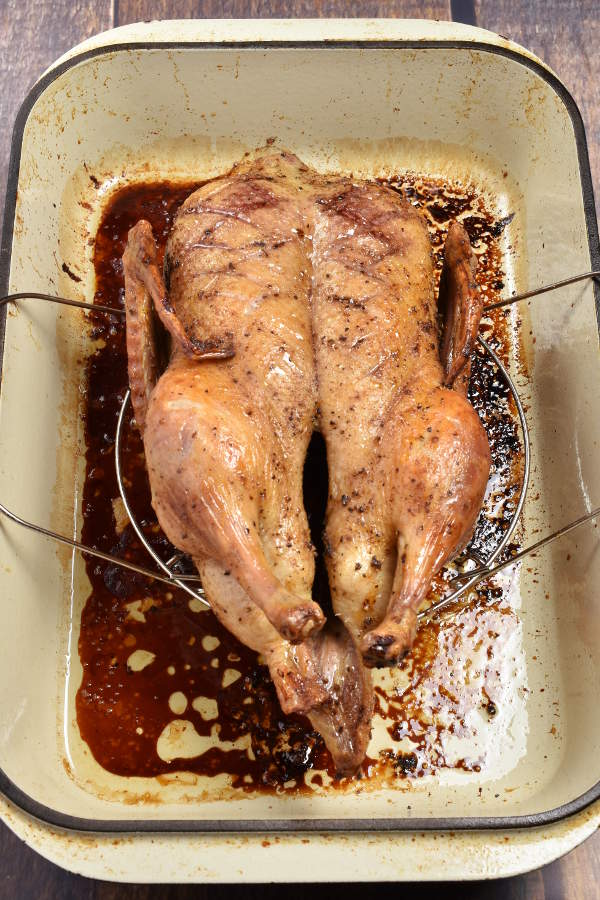
How Long to Roast Duck in the Oven?
I roasted this duck for a total of 2 hours, 15 minutes at 350 degrees.
The packaging on my duck suggested roasting for 30 minutes per pound at 350 degrees, which would have been 2 ½ hours. I think that is just a little too long. If you duck is larger or smaller than 5 pounds, however, you may want to roughly follow that guideline to adjust the cooking time.
Important note: I tried putting the finished duck under the broiler to really crisp up the skin more, but after only 30 seconds under the broiler, it burned the skin badly. (That is not the duck you see in these photos.) I do not recommend broiling.
What to Serve with Roast Duck with Maple Glaze
I enjoy roast duck with potatoes as a side. If you save the duck fat while you’re roasting the duck, you can use it to make the duck fat fried potatoes from this recipe. I also have a simple recipe for oven roasted potatoes as a side to another duck recipe I shared here.
I’ve also had duck with baked sweet potato fries and with rice as sides – both work well. Serve with a side salad or steamed vegetable to round out your meal.
For garnish, I chose cranberries and pomegranate to visually highlight the flavors from the cranberry-pomegranate juice blend I used in the glaze. For a more edible garnish, go with fresh blackberries or cherries—both are great with duck.
Is Roast Duck Good Leftover?
Yes! Reheat leftover duck in a 400 degree oven for 10 minutes. Leftover duck can be kept in the fridge for up to a week.
Looking for more duck recipes? If you don’t want to roast a whole duck, check out my recipe for Duck Breast a L’Orange with Oven Roasted Potatoes or Duck Breast with Cherry Sauce and Duck Fat Fried Potatoes.
If you make this recipe, please give the recipe a rating and/or leave a comment. I’d love to hear from you!
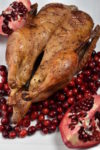
Roast Duck with Maple Glaze
Roast Duck with Maple Glaze has crispy skin and juicy meat. The sweet flavors from maple syrup and fruit juice complement the taste of rich duck meat. A whole roast duck is an easy yet impressive main dish for your next special occasion or holiday dinner.
Ingredients
- 1 (5 pound) white pekin duck (aka Long Island duck)
- 2 teaspoons kosher salt
- 1 teaspoon coarsely ground black pepper
- 1/2 teaspoon paprika
- 1/4 cup maple syrup
- 1/4 cup pomegranate or cranberry juice (or juice blend)
Instructions
Preheat oven to 350 degrees. Place some type of roasting rack in a large roasting pan. You just need something to keep the duck off the bottom of the roasting pan where the fat drippings will collect. (I used the steamer insert from my Instant Pot. Leave the sides out to easily lift the duck out of the pan later.)
Remove any giblets from duck cavity and save for another use or discard. Pat duck dry with paper towels inside and outside. Rub salt, pepper, and paprika all over the outside of the duck. Run a knife diagonally over the skin over the breast to score it in a crisscross pattern, being careful not to cut all the way through the skin. This will help the fat render (meaning change from solid form to liquid form) as it cooks. Score the skin over the thighs and anywhere else there are thick areas of fat. (See photos for illustration.) Tie the legs together with cooking twine. Place the duck over your improvised or real roasting rack, breast side up.
Roast duck for 1 hour. Remove from oven. Carefully remove rendered fat from roasting pan. You may want to transfer the duck to a plate first and then pour out the fat.
Turn the duck over breast side down and roast for an additional 45 minutes. Remove fat from roasting pan again.
Turn the duck breast side up again. Mix maple syrup and juice together in a small bowl. Brush half of the mixture over the duck. Roast for 15 minutes.
Remove from oven. Brush remaining glaze over the duck. Roast for 15 minutes.
Check if duck is cooked through. Duck should reach in internal temperature of 165 degrees, between the thigh and the breast. If your duck needs more time, check again in 10-15 minutes. Let rest 10 minutes before carving.
Recipe Notes
Most grocery stores sell whole duck like this frozen. It takes at least 48 hours to fully defrost a frozen duck in the fridge, but I would leave 3 days if possible to be on the safe side.
Bon Appétit!
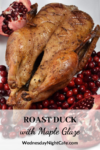
Can you use orange juice in place of cranberry juice?